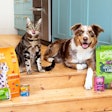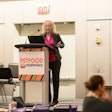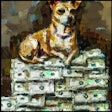The recent turmoil in China’s economy does not seem to be affecting the country’s pet food market, judging by the major, active presence of pet food companies at last week’s Pet Fair Asia in Shanghai. With this activity backed by data showing the market’s continuing rapid growth (presented by Pushan Tagore of GfK during Petfood Forum China 2015 on August 28), China promises to be an up and coming pet food player for some time.
In its 18th year, Pet Fair Asia, one of China’s largest pet trade shows, has also seen steady growth. This year it expanded to three halls, and many of the exhibiting pet food manufacturers, both domestic and multinational, had very large stands. In fact, for most of the multinationals, their stands were larger than what they typically have at North American pet trade shows such as Global Pet Expo.
One Chinese pet food manufacturer, Bridge Petcare (using the brand name Nature Bridge), had not only a large stand but also a “2015/2016 International Pet Food Trend Show,” in which young models strutted around a stage carrying the company’s pet food products. The stand also had artfully arranged displays of ingredients used in the products. While at the stand, I spoke with a pet food professional from Europe who was meeting with people from Bridge; he said they had told him their company now is the second largest in China, behind only Mars Petcare. So far I have not been able to confirm that claim, but I do know Bridge’s presence at Pet Fair Asia has grown each of the last three years.
This growth is in keeping with China’s overall pet food market, which Tagore reported has been rising by double digits since 2013. And, that growth is only increasing, with projections from GfK for sales to grow 12.3% this year and 13.5% in 2016. Currently, the market size is at about 8.4 billion CNY (US$1.37 billion).
Besides its rapid growth, what sets China’s pet food market apart is that online sales continue to increase their share, with Tagore projecting them to account for 38% of the market by the end of this year and 43% in 2016. To date for 2015, online pet food sales in China have reached 3.2 billion CNY (US$504.8 million).
China’s pet food retail environment in general differs from much of the rest of world. Globally, GfK data shows an even split for pet food sales between specialized retailers—pet shops and supermarkets, veterinary clinics, online, farm and feed stores and do-it-yourself/garden centers—and mass merchants/food retailers (grocery stores and supermarkets, hypermarkets, discount stores). China’s sales skew heavily toward specialized retailers, at 80%, vs. mass merchants/food. In comparison, Brazil has a similar skew to China’s, at 70% specialized retailers/30% mass/food, while Western Europe is the opposite, with only 35% in specialized retailers but 65% in mass/food.
Another key differentiator for China is that the average monthly expenditure on dog food is only US$0.98, far below most markets except for other developing ones such as Ukraine (US$0.85, and likely affected by recent strife there), Egypt (US$0.79), India (US$0.55), Philippines (US$0.24) and Vietnam (US$0.06). The top five markets for average monthly dog food spending are either in Western Europe (Norway, Switzerland, Sweden and Austria) or Australia, Tagore said, with expenditures ranging from US$53.22 to US$28.44. However, the European Union average is only US$14.81, below that for the US (US$20.08).
The low average monthly expenditure in China is likely because premiumization has not yet reached a significant level there. GfK has started tracking sales of pet food labeled “natural” in China, and while those sales are small—only 6% for cat food and 19% for dog food—they’re rising rapidly, at nearly 200% and 75%, respectively. Not surprisingly, given its popularity in so many other markets, grain-free pet food is even starting to show up in China. Sales account for only 1% of the market but are growing at 379% a year.
Diving into specific pet food product categories in China, Tagore showed that dog food dominates, at least in “offline” sales in the two largest cities/markets, Beijing and Shanghai, where dog food accounts for 75% of sales. However, sales of cat food are growing faster, at 24%, vs. 8% growth for dog food. Online, cat food has a 33% share of all pet food sales and is increasing at 25%, but dog food sales are rising 45%.
Whether looking at the offline sales in the two largest cities or online sales, dry pet food rules in China, Tagore reported, at 81% and 83%, respectively, with wet food at 11% and 9% and treats at 8% in both channels. That means dog treats, because at least in the offline channel, GfK’s data shows no treat sales for cats. Among those dog treats sold in Beijing and Shanghai, chewables/meat-based (presumably jerky-type) treats dominate in terms of format, far outpacing other forms such as soft, rawhide and crunchy/crispy.
As more people in China move into the middle class—at least in urban areas, household income per capita is continuing to increase 7% to 9% a year, despite the recent economic downturn—more and more will own pets. In fact, China now is the third largest dog-owning market globally, Tagore said, with 27.4 million dogs (behind the US with 55.3 million dogs and Brazil with 35.7 million), and the second largest cat-owning country with 58.1 million cats, behind only the US with 80.6 million.
Going by the stands at Pet Fair Asia, as well as the pet owners present, humanization has already taken hold in China. As more pet owners buy commercially prepared pet food, they no doubt will latch on to the trends driving pet food sales in the rest of the world, such as natural, grain-free, other specialty foods and treats. With China and pet food, the sky seems to be the limit.

















